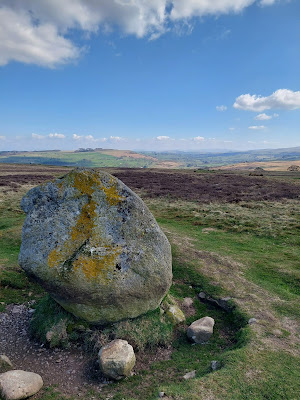Penrith, Cumbria. Tuesday 18-April-2023.
The Eamont Way is a new walking route of 5.5 miles from Penrith Railway Station to Pooley Bridge Steamer Pier. It is the work of Friends of the Ullswater Way. It is actually a collection of existing paths with new signs and gates and was only inaugurated on Friday 14th April, a few days before this walk.
Having missed the inaugural walk we decided to give it a go ourselves and then walk back via Askham following another walk from my Lake District Walks with History book. The latter is described as "an atmospheric walk across lonely moors dotted with mysterious Bronze Age remains".
Part 1: Outbound along the Eamont Way.
We downloaded and printed off the map.
We then walked up to the station and found the start point. A short walk down to the A66 and then cut off down a side path.
River Eamont. Fairly full after recent rains.
This barn conversion near Sockbridge is called Wordsworth Cottage. Apparently it was formerly part of the estate once owned by Wordsworth’s grandfather who lived in nearby Sockbridge Hall.
The route goes through a mixture of fields and lovely country lanes.
We saw many daffodils but not yet up to Wordsworths "A host, of golden daffodils". We also saw many cute lambs who all ran to Mum when you approached the fence to take a photo.
Kirkbarrow Hall. This Gothic house on the main road, now a dairy farm, once belonged to Leonard Dacre, described by Queen Elizabeth as a "very cankred subtill traitor" for his role in the Rising of the North (1569). Read more on the Friends of the Ullswater Way site.
The walk is pretty level, no huge ups and down through beautiful countryside.
The boat house at Pooley Bridge and the end of the Eamont Way.
Part 2: Return via Askham Fell.
A lovely place for a rest, looking over Ullswater.
Getting up onto Askham fell with views of Ullswater.
Galava & Brocavum were two local Roman forts. The Roman mile (mille passus, lit. "thousand paces"; abbr. m.p.) consisted of a thousand paces as measured by every other step—as in the total distance of the left foot hitting the ground 1,000 times.
The bronze age Cockpit stone circle. According to the book no-one knows for sure why it was built or why, as friend have pointed out, the grass is always greener inside the circle.
The Cop Stone, another Bronze Age mystery. About 1.5m high and 1m thick, today a solitary stone but believed originally to be part of a cairn ring about 20m in diameter.
Heading back to Askham, the imposing Lowther Castle with the Pennines in the background.
Moving time 5:09:20. Distance 25.23km.
Lovely day for it but about 25km in all so definitely felt a bit weary afterwards. Our poor feet!



















No comments:
Post a Comment